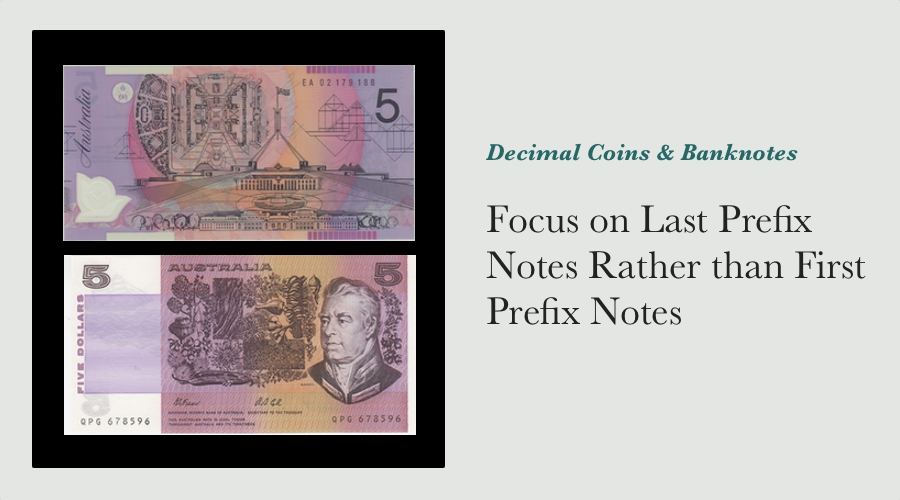Focus on Last Prefix Notes Rather than First Prefix Notes

When it comes to collecting Australian banknotes, there are two key types of notes that will add value to your collection - first prefix and last prefix banknotes. While it would seem obvious that first prefix banknotes, i.e. the first notes printed in a series, are more valuable, most often it’s actually last prefix banknotes that fetch a higher price tag. If you are serious about adding value to your banknote collection, this is where you should be focusing your efforts.
Australian banknote serial numbers explained
It helps to know how Australian banknote serial numbers work in order to understand the distinction between first and last prefixes.
Banknote serial numbers start with 2 or 3 letters, e.g. AA or JK. This is the prefix. The two numbers following the prefix indicate the year the banknote was printed. E.g. a serial number that starts with AA00 indicates a note that was printed in the year 2000. The numbers that follow are the serial number.
Novice collectors often get excited to find a set of consecutive serial number banknotes but given the volume of banknotes in circulation - 1.8 billion as at June 2020 - this isn’t actually as rare, or valuable, as they would have hoped.
Why are last prefix banknotes more valuable?

1988 $10 Note AB 33 Last Prefix
The market for collecting first and last prefix banknotes didn’t emerge until the late 1990s. Collectors started chasing the AB10 first prefix 1988 polymer notes. The AB33 and AB57 last prefix banknotes from the same series followed from there. The rest is history.
Many collectors will chase both first and last prefix banknotes equally. They enjoy the thrill of the chase and adding as much as they can to their collection.
But, in many cases, last prefix banknotes are more valuable because less collectors set them aside initially. As the majority of collectors had their eyes firmly set on the “first prefix” prize, a true minority of collectors realised that there was value in the last notes printed in a series.
At the time, information on prefixes wasn’t readily publicised by the RBA so collectors had to work out the last prefix information for themselves. The JK98 is the rarest polymer $100 prefix ever issued. At the time this note, and other similarly rare last prefix notes, were in circulation, people didn’t actually know how rare they were.
Determining the value of an Australian banknote
Part of the appeal of collecting banknotes is that it isn’t easy. If it was, everyone would do it. But because it requires some effort, the satisfaction of finding a rare item to add to your collection is significant.
To a non-collector, the serial number is just an identifier, and often something they will never even notice. To those of us with an interest in numismatics, that number tells a story of the rarity and value of the note. Always remember that condition is a huge determining factor in the value of a note. A rare note in mint condition is far more valuable than one with signs of wear and tear.
If you want to learn more about the different prefixes and their possible values, Rennik’s Guide is a good place to start. With a little research you will have more chances of knowing a real treasure when you find it.
Comments (1)
Ease of identifying and collecting
By: Reader on 5 October 2022Another factor is that first prefix notes are easier to identify: they're AA. Last prefix notes vary depending on the year and denomination. It's much easier to get some AA notes out of an ATM or the bank and set them aside than to need to check if the notes with other letter prefixes are last prefixes or not. Similarly in selling: it's easy to identify a note with AA is first prefix, but it requires more effort to confirm a vendor is telling the truth that a JK10 or EF20 prefix is actually the last prefix for that year. The RBA does publish this information (Australian note collectors are fortunate for this), but again, extra effort to cross reference and verify. More work to identify and set aside = more valuable.